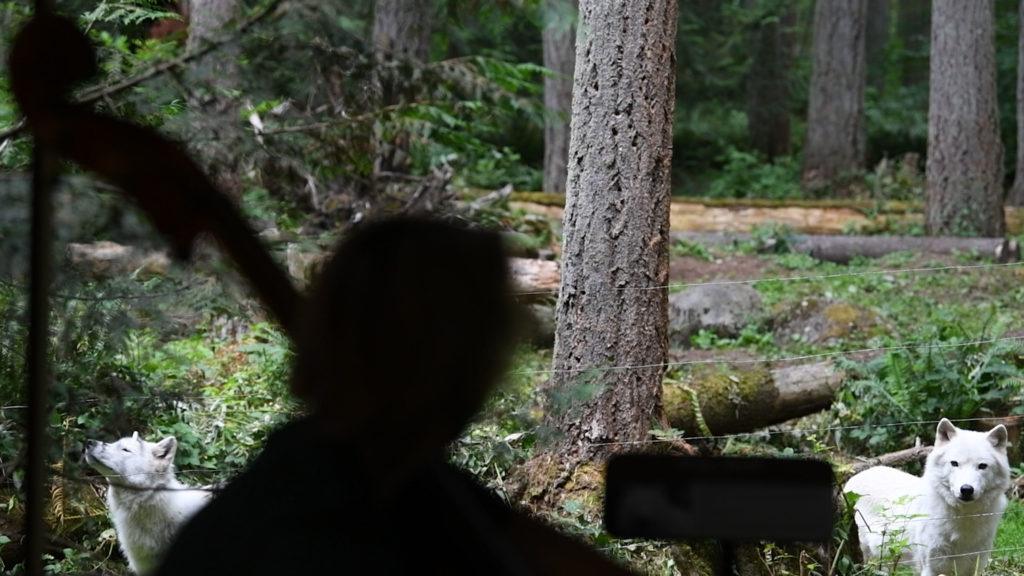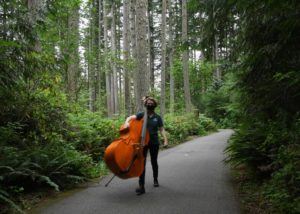
I had my howls all ready to go.
When Northwest Trek keepers agreed I could try playing some music to our gray wolves, I was stoked. I’m primarily a writer in our marketing department – I run our websites and write blog stories, emails and more. But I’m also a classically-trained musician and have, in the last few years, developed a unique voice improvising on double bass using a looping pedal to create my own harmonies. I especially love taking this music outside, incorporating natural sounds like whalesong and birdsong.
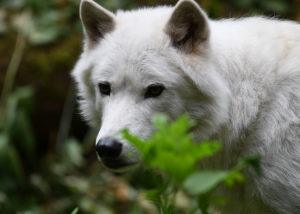 Playing music for actual wolves took this to a whole new level. I researched wolf howls at home, listening to endless audio files and noting pitches, especially those semi-discordant drops of a tone, then half-tone, echoed by other wolves at augmented intervals and joining into an eerie chorus. I practiced on my dogs at home, and couldn’t wait to see if Trek’s gray wolves would howl along with me.
Playing music for actual wolves took this to a whole new level. I researched wolf howls at home, listening to endless audio files and noting pitches, especially those semi-discordant drops of a tone, then half-tone, echoed by other wolves at augmented intervals and joining into an eerie chorus. I practiced on my dogs at home, and couldn’t wait to see if Trek’s gray wolves would howl along with me.
Finally, it was time. I walked my bass along the winding, forested paths at 8am, long before guests arrived, to set up at the wolf viewing deck. Instantly Tala (a female) and Canagan (a male) came to check me out.
I nodded hi to keepers Carly and Jordan, who were there to observe, and began tuning.
“You know they usually don’t howl while we’re around,” Jordan said, and my spirits deflated a little. “They wait until we’ve left, then they start. But you never know. Lots of things set them off: car alarms, sirens, other animal sounds.”
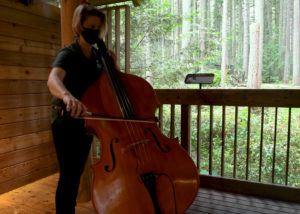
Tentatively, I played the first few notes, and set them going on a loop, my eyes fixed on Canagan and Tala. Instantly their ears perked up, and they stared at me, bodies on alert (or so it seemed to me). I kept going, adding loop upon loop, building up a calm but slightly edgy tonality of A major with a flattened seventh.
Then I added a howl. High above the staff, which for the low pitch of a double bass (twice the size and depth of a cello) ends up in normal female singing range.
Nothing from the wolves. They wandered around a little, perking up when I added new melodies. I tried another song (I compose all my own music), this one written specifically for them: a loop of swift, pacing eighth notes, with long bass notes alternating between G major and E minor. Some louder, fiercer pulls on my lowest E string got Canagan’s attention, and encouraged, I started the howls again, this time looping them so they echoed themselves like a wolf pack.
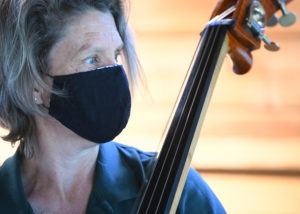
Now Tala was also pacing near the fence. I double-checked with Carly and Jordan, ready to stop if it were upsetting them, but Carly smiled encouragingly. Higher and higher I played up the fingerboard, reaching up into true soprano range. Some nearby birds joined in and I “sang” back to them, sharing a little grin with Carly.
Finally, I launched into another new song: a slow, Appalachian-style waltz with nonchalant pizzicato bass line and sweet, nostalgic harmonies. Over the top I layered in just a few wolf howls, a musical commentary on how humans and wolves can hopefully live in harmony. Tala, nestled into green ferns, had gone to sleep.
When I bowed the last note and slowly faded out the harmony loops, all was completely still. Canagan and Tala looked up briefly, as if to say, “Why did you stop?”
“That was great,” said Carly. “They seemed to really respond to it.”
But no howling. I packed up, along with our videographer Katie, and waved goodbye to the keepers as we set off down opposite paths. Just as we rounded the bend, the first guests appearing in the distance, I heard a faint but unmistakable sound.
Wolf howls.
-Rosemary Ponnekanti
